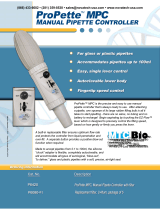
5. The float in the overflow
valve doesn’t close
If the cap has been washed,
ensure that the float is not partially
detached
Insert the float into its proper position
6. The float in the overflow
valve doesn’t close
The float it’s covered by dirty
material
Unscrewed the cap, wash the overflow valve in clean
water, and replace.
Fill the bottle to 1/3 capacity with water
Faults 1 - 2 - 3 - 4 - 5 - 6 - 7
None of the remedies has
achieved the desired results
Contact Benchmark Scientific for Service Assistance
If the overfill valve system fails, continued aspiration will cause liquid to contact the bacteriological filter and air flow
will be blocked.
Should this back-up security also fail, there is a risk of liquid entering the vacuum pump system. Do not attempt to
continue using the Aspirator in the event of liquid entering the vacuum pump system. Contact Benchmark Scientific
for Service Assistance.
Benchmark Scientific will provide upon request electric diagrams, components list, descriptions, setting
instructions and any other information to assist with quick repair.
IN THE EVENT OF DAMAGED PARTS OR ABNORMAL OPERATION, PLEASE CONTACT BENCHMARK TECHNICAL
SERVICE. THE MANUFACTURER CANNOT HONOR THE WARRANTEE IF THERE HAS BEEN AN UNAUTHORIZED
ATTEMPT AT REPAIRING THE INTERNAL COMPONENTS.
Place the Aspire Aspirator on a flat, horizontal surface
Connect the end of the short silicon tube, with antibacterial filter, to the suction connector.
The other tube already connected to the filter has to be connected to the port on the bottle cap labelled
“VACUUM”. This is the port with the overflow prevention valve directly below. When the collection bottle is
90% full, the overflow prevention valve will be activated to block liquid from traveling to the filter and pump
system.
WARNING: Ensure that the filter is installed correctly and that the side marked “IN” is toward the collection
bottle. If the filter is installed incorrectly, liquid may come through the filter and cause damage to the pump system.
Connect the long silicone tube to the “SAMPLE” port on the bottle lid.
Connect the other end of the long silicon tube to the hand held vacuum pipette.
Connect the power cord to the device then connect the power cord to an appropriate electrical outlet.
Optional: Put some water, disinfecting liquid (ie 10% bleach to water), and/or antifoam agent into the collection
bottle prior to aspiration of samples. It may be filled to 1/3 capacity with this liquid. Adding liquid prior to use
will provide easier cleaning, may help prevent growth of biological contaminants, and will also increase the
speed to reach full vacuum level.
Push the green power switch on the front of the instrument to the on “I” position to start suction.
During operation the collection bottle must remain in a vertical position to prevent the overflow protection valve
from cutting off suction. Should this happen, switch off the device and disconnect the tube from the jar cover
(from “VACUUM” outlet).
Once finished push switch on O position and unplug.
















